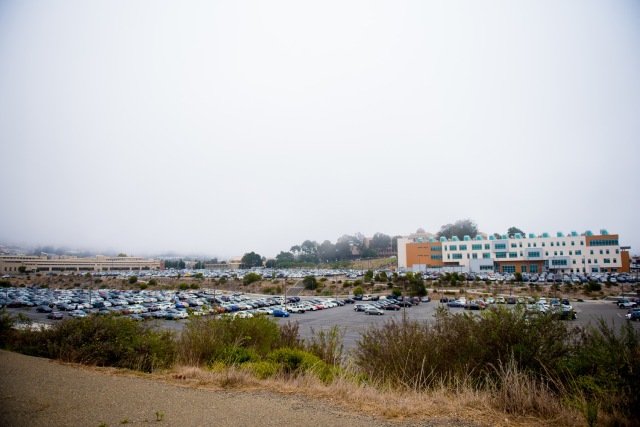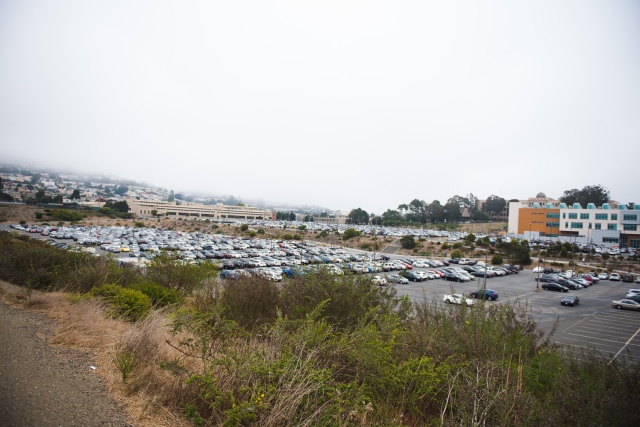Reprinted with permission from City College’s newspaper, The Guardsman: http://theguardsman.com/parking-crisis/
Parking crisis raises Balboa Reservoir Project concerns

September 13, 2017 The Guardsman
By Bethaney Lee
The Guardsman photographed the usage of the parking lot in contention with the Balboa Reservoir Project (BRP) every hour on Aug. 28, and concluded it was used consistently throughout the day. It was highly impacted at peak class hours and the surrounding neighborhoods and streets cannot support the amount of vehicles displaced by the removal of the lower parking lot.
Tensions first arose after the BRP reported its goal was to repurpose the lot into mixed-income level housing.
In October 2016, Nelson Nygaard released the Balboa Area Transportation Demand Management (TDM) Plan which was used to identify transportation needs for the Balboa Park area. The report identified limited roadway space, transit infrastructure and financial resources as three primary problems.
“Yet despite the obvious fact that the elimination of student parking and the addition of new Reservoir residents will increase demand placed on limited transportation resources, the Balboa Reservoir Project Team proposes no amelioration for adverse impacts other than TDM,” Professor William McGuire said in an email sent in early January 2017.

The Guardsman’s observation took place over the course of several weeks, and the research provided legitimacy to Professor Rick Baum’s fears that the project could “interfere with efforts to increase student enrollment.”
In an email, sent in late August to the Board of Trustees’ President Thea Selby, Baum asked Selby to explain “how the housing project, that might be built on the Public Utilities Commission (PUC) section of the reservoir, could possibly serve the needs of CCSF’s students?” Additionally, because many students must commute by car and use the controversial section of the reservoir for parking, Baum asked if Selby could “please explain how…any student [would] even be able to afford to live in the housing being contemplated?”

With inquiries stretching as far as potentially using the land for the voter approved Performing Educational Arts Center, Baum gave voice to what many people from Ocean Campus have already been talking about.
In response, Selby issued an email to the community on Aug. 24, 2017, which said, “City College is a vital partner to this project as it moves forward over the next several years.”
For more information, visit the Balboa Reservoir Community Advisory Committee website.


Reprinted with permission from City College’s newspaper, The Guardsman: http://theguardsman.com/parking-crisis/

By the way, parking was free the first two weeks of classes, 8/21 to 9/1, so parking would be lot heavier than during the rest of the semester. Go and take a look at the lower lot now. Its nearly empty, even with the low, low fee of $3 per day.
The Transportation Demand Management Plan offers more than just identifying problems in the area. If the author of this article had read the plan he would know that it contains a whole chapter devoted to measures CCSF can take to reach an auto mode share of no more than 20% among its students and employees and a monitoring program that would insure that goals are met and maintained. Measures include a free transit pass for students, bike parking and bike share stations, shuttles to BART that stop at child care centers, and of course affordable housing for students in the reservoir and on campus.
The draft TDM is ninety one pages long! There is too much to reprise here and obviously too much for the Guardian writer to bother to read! Read it for yourself (PDF) here:
https://goo.gl/tR63AL
Many other community colleges have managed to grow their enrollment and achieve their educational goals without large, wasteful parking lagoons and instead devote more resources to classrooms and student services. They have chosen to rebuild their commute from the ground up in a way that is more efficient, cost effective and sustainable.
Here’s an NYT article to balance the Guardsman’s:
https://goo.gl/xjr9ZD
The TDM referred to has no data from the evening classes–it did not collect data during the hours between 7 and 10 and instead collected data at 10:30 when school was out and the parking lot was empty. This is problematic because one of the suggested solutions is for a shared parking structure where the students have access during the day and the residents of the new development use the lot at night.
Not included in the TDM is the statistic from Muni that shows the “43”, one of the Muni lines to access the area being very late during the months of September and October–that would be Back to School time at City College. A logical leap is that the bus is late during those two months because it is loaded with City College students trying in vain to get to their classes on time and assuredly not getting to ride for free.
Perhaps what Mr. Pippenger has recorded in his article is the true “peak usage” for the reservoir, much more so than what was recorded in the TDM as “peak usage” with data taken in May during the last week of class right before finals–otherwise known as dead week.